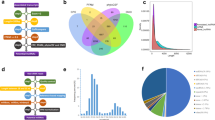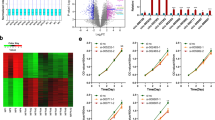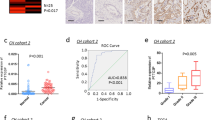Abstract
MicroRNAs (miRNAs) have been involved in the pathogenesis of different types of cancer; however, their function in pituitary tumorigenesis remains poorly understood. Cyclic-AMP-dependent protein kinase-defective pituitaries occasionally form aggressive growth-hormone (GH)-producing pituitary tumors in the background of hyperplasia caused by haploinsufficiency of the protein kinase’s main regulatory subunit, PRKAR1A. The molecular basis for this development remains unknown. We have identified a 17-miRNA signature of pituitary tumors formed in the background of hyperplasia (caused in half of the cases by PRKAR1A-mutations). We selected two miRNAs on the basis of their functional screen analysis: inhibition of miR-26b expression and upregulation of miR-128 suppressed the colony formation ability and invasiveness of pituitary tumor cells. Furthermore, we identified that miR-26b and miR-128 affected pituitary tumor cell behavior through regulation of their direct targets, PTEN and BMI1, respectively. In addition, we found that miR-128 through BMI1 direct binding on the PTEN promoter affected PTEN expression levels and AKT activity in the pituitary tumor cells. Our in vivo data revealed that inhibition of miR-26b and overexpression of miR-128 could suppress pituitary GH3 tumor growth in xenografts. Taken together, we have identified a miRNA signature for GH-producing pituitary tumors and found that miR-26b and miR-128 regulate the activity of the PTEN–AKT pathway in these tumors. This is the first suggestion of the possible involvement of miRNAs regulating the PTEN–AKT pathway in GH-producing pituitary tumor formation in the context of hyperplasia or due to germline PRKAR1A defects. MiR-26b suppression and miR-128 upregulation could have therapeutic potential in GH-producing pituitary tumor patients.
This is a preview of subscription content, access via your institution
Access options
Subscribe to this journal
Receive 50 print issues and online access
$259.00 per year
only $5.18 per issue
Buy this article
- Purchase on Springer Link
- Instant access to full article PDF
Prices may be subject to local taxes which are calculated during checkout






Similar content being viewed by others
References
Bartel DP . MicroRNAs: Genomics,biogenesis,mechanism and function. Cell 2004; 116: 281–297.
Croce CM, GA Calin . MicroRNAs cancer and stem cell division. Cell 2005; 122: 6–7.
Takamizawa J, Konishi H, Yanagisawa K, Tomida S, Osada H, Endoh H et al. Reduced expression of the let-7 microRNAs in human lung cancers in association with shortened postoperative survival. Cancer Res 2004; 64: 3753–3756.
Iorio MV, Ferracin M, Liu CG, Veronese A, Spizzo R, Sabbioni S et al. MicroRNA gene expression deregulation in human breast cancer. Cancer Res 2005; 65: 7065–7070.
Bandres E, Bitarte N, Arias F, Agorreta J, Fortes P, Agirre X et al. MicroRNA-451 regulates macrophage migration inhibitory factor production and proliferation of gastrointestinal cancer cells. Clin Cancer Res 2009; 15: 2281–2290.
Metzler M, Wilda M, Busch K, Viehmann S, Borkhardt A . High expression of precursor microRNA-155-/BIC RNA in children with Burkitt lymphoma. Genes Chromosome Cancer 2004; 39: 167–169.
He H, Jazdzewski K, Li W, Liyanarachchi S, Nagy R, Volinia S et al. The role of microRNA gene in papillary thyroid carcinoma. Proc Natl Acad Sci USA 2005; 102: 19075–19080.
Stilling G, Sun Z, Zhang S, Jin L, Righi A, Kovacs G et al. MicroRNAs expression in ACTH-producing pituitary tumors up regulation of microRNA-122 and -493 in pituitary carcinoma. Endocrine 2010; 38: 67–75.
Rahbari R, Holloway AK, He M, Khanafshar E, Clark OH, Kebebew E . Identification of differentially expressed microRNA in parathyroid tumors. Ann Surg Oncol 2011; 2: 1158–1165.
Asa SL, Ezzat S . The cytogenesis and pathogenesis of pituitary adenoma. Endocr Rev 1998; 19: 798–827.
Asa SL, Ezzat S . The pathogenesis of pituitary tumors. Nat Rev Cancer 2001; 2: 836–849.
Bottoni A, Piccin D, Tagliati F, Luchin A, Zatelli MC, degli Uberti EC . MiR-15a and miR-16-1 downregulation in pituitary adenomas. J Cell Physiol 2005; 204: 280–285.
Bottoni A, Zatelli MC, Ferracin M, Tagliati F, Piccin D, Vignali C et al. Identification of differentially expressed microRNAs by microarray: a possible role for microRNA genes in pituitary adenomas. J Cell Physiol 2007; 210: 370–377.
Amaral FC, Torres N, Saggioro F, Neder L, Machado HR, Silva WA et al. MicroRNAs differentially expressed in ACTH-secreting pituitary tumors. J Clin Endocrinol Metab 2009; 94: 320–323.
Pack S, Kirshner LS, Pak E, Carney JA, Zhuang Z, Stratakis CA . Pituitary tumors in patients with the “complex of spotty skin pigmentation, myxomas, endocrine overactivity and schwannomas” (Carney complex): evidence for progression from somatomammotroph hyperplasia to adenoma. J Clin Encocrinol Metab 2000; 85: 3860–3865.
Pack SD, Qin LX, Pak E, Wang Y, Ault DO, Mannan P et al. Common genetic changes in hereditary and sporadic pituitary adenomas detected by comparative genomic hybridization. Genes, Chromosomes Cancer 2005; 43: 72–82.
Galland F, Kamenicky P, Affres H, Reznik Y, Pontvert D, Le Bouc Y et al. McCune-Albright syndrome and acromegaly: effects of hypothalamopituitary radiotherapy and/or pegvisomant in somatostatin analog-resistant patients. J Clin Endocrinol Metab 2006; 91: 4957–4961.
Boikos SA, Stratakis CA . Pituitary pathology in patients with Carney Complex: growth-hormone producing hyperplasia or tumors and their association with other abnormalities. Pituitary 2006; 9: 203–209.
Bossis I, Voutetakis A, Matyakhina L, Pack S, Abu-Asab M, Bourdeau I et al. A pleiomorphic GH pituitary adenoma from a Carney complex patient displays universal allelic loss at the protein kinase A regulatory subunit 1A (PRKARIA) locus. J Med Genet 2004; 41: 596–600.
Song LB, Li J, Liao WT, Feng Y, Yu CP, Hu LJ et al. The polycomb group protein Bmi-1 represses the tumor suppressor PTEN and induces epithelial-mesenchymal transition in human nasopharyngeal epithelial cells. J Clin Invest 2009; 119: 3626–3636.
Cimmino A, Calin GA, Fabbri M, Iorio MV, Ferracin M, Shimizu M et al. MiR-15 and miR-16 induce apoptosis by targeting BCL2. Proc Natl Acad Sci USA 2005; 102: 13944–13949.
Johnson SM, Grosshans H, Shingara J, Byrom M, Jarvis R, Cheng A et al. Ras is regulated by the let-7 microRNA family. Cell 2005; 120: 635–647.
Mayr C, Hemann MT, Bartel DP . Disrupting the pairing between let-7 and Hmga2 enhances oncogenic transformation. Science 2007; 315: 1576–1579.
Iliopoulos D, Hirsch HA, Struhl K . An epigenetic switch involving NF-kappaB, Lin-28, Let-7 MicroRNA, and IL-6 links inflammation to cell transformation. Cell 2009; 139: 693–706.
Chang TC, Yu D, Lee YS, Wentzel EA, Arking DE, West KM et al. Widespread microRNA repression by Myc contributes to tumorigenesis. Nat Genet 2008; 40: 43–50.
Kashuba VI, Li J, Wang F, Senchenko VN, Protopopov A, Malyukova A et al. RBSP3 (HYA22) is a tumor suppressor gene implicated in major epithelial malignancies. Proc Natl Acad Sci U S A 2004; 101: 4906–4911.
Incoronato M, Garofalo M, Urso L, Romano G, Quintavalle C, Zanca C et al. MiR-212 increases tumor necrosis factor-related apoptosis-inducing ligand sensitivity in non-small cell lung cancer by targeting the antiapoptotic protein PED. Cancer Res 2010; 70: 3638–3646.
Godlewski J, Nowicki MO, Bronisz A, Williams S, Otsuki A, Nuovo G et al. Targeting of the Bmi-1 oncogene/stem cell renewal factor by microRNA-128 inhibits glioma proliferation and self-renewal. Cancer Res 2008; 68: 9125–9130.
Huse JT, Brennan C, Hambardzumyan D, Wee B, Pena J, Rouhanifard SH et al. The PTEN-regulating microRNA miR-26a is amplified in high-grade glioma and facilitates gliomagenesis in vivo. Genes Dev 2009; 23: 1327–1337.
Di Cristofano A, De Acetis M, Koff A, Cordon-Cardo C, Pandolfi PP . Pten and p27KIP21cooperate in prostate cancer tumor suppression in the mouse. Nat Genet 2001; 27: 222–224.
Podsypanina K, Ellenson LH . Mutation of PTEN/Mmac1 in mice causes neoplasia inmultiple organ systems. Proc Natl Acad Sci USA 1999; 96: 1563–1568.
Trotman LC, Niki M, Dotan ZA, Koutcher JA, Di Cristofano A, Xiao A et al. Pten dose dictates cancer progression in the prostate. Plos Biol 2003; 1: 1E59.
Xia D, Srinivas H, Ahn YH, Sethi G, Sheng X, Yung WK et al. Mitogen activated protein kinase kinase-4 promotes cell survival by decreasing PTEN expression throught an NF-kappa B-dependent pathway. J Biol Chem 2007; 282: 3507–3519.
Molofsky AV, Pardal R, Iwashita T, Park IK, Clarke MF, Morrison SJ . Bmi-1 dependence distinguishes neural stem cell self-renewal from progenitor proliferation. Nature 2003; 425: 962–967.
Jacobs JJ, Kieboom K, Marino S, DePinho RA, van Lohuizen M . The oncogene and Polycomb-group gene bmi-1 regulates cell proliferation and senescence through the ink4a locus. Nature 1999; 397: 164–168.
Jacobs JJ, Scheijen B, Voncken JW, Kieboom K, Berns A, van Lohuizen M . Bmi-1 collaborates with c-Myc in tumorigenesis by inhibiting c-Myc-induced apoptosis via INK4a/ARF. Genes Dev 1999; 13: 2678–2690.
van Lohuizen M, Frasch M, Wientjens E, Berns A . Sequence similarity between the mammalian bmi-1 proto-oncogene and the Drosophila regulatory genes Psc and Su(z)2. Nature 1991; 353: 353–355.
Guo BH, Feng Y, Zhang R, Xu LH, Li MZ, Kung HF et al. Bmi-1 promotes invasion and metastasis, and its elevated expression is correlated with an advanced stage of breast cancer. Mol Cancer 2011; 10: 10.
Lukacs RU, Memarzadeh S, Wu H, Witte ON . Bmi-1 is a crucial regulator of prostate stem cell self-renewal and malignant transformation. Cell Stem Cell 2010; 7: 682–693.
Liu WL, Guo XZ, Zhang LJ . Prognostic relevance of Bmi-1 expression and autoantibodies in esophageal squamous cell carcinoma. BMC Cancer 2010; 10: 467.
Sinha AU, Kaimal V, Chen J, Jegga AG . Dissecting microregulation of a master regulatory network. BMC Genomics 2008; 9: 88.
Stratakis CA, Tichomirowa MA, Boikos S, Azevedo MF, Lodish M, Martari M et al. The role of germline AIP, MEN1, PRKAR1A, CDKN1B and CDKN2C mutations in causing pituitary adenomas in a large cohort of children, adolescents, and patients with genetic syndromes. Clin Genet 2010; 78: 457–463.
Farrell WE, Azevedo MF, Batista DL, Smith A, Bourdeau I, Horvath A et al. Unique gene expression profile associated with an early-onset multiple endocrine neoplasia (MEN1)-associated pituitary adenoma. J Clin Endocrinol Metab 2011; 96: E1905–E1914.
Kirschner LS, Carney JA, Pack SD, Taymans SE, Giatzakis C, Cho YS et al. Mutations of the gene encoding the protein kinase A type I-alpha regulatory subunit in patients with the carney complex. Nat Genet 2000; 26: 89–92.
Kovacs K, Horvath E, Thomer MO, Rogol AD . Mammosomatotroph hyperplasia associated with acromegaly and hyperprolactinemia in a patient with the McCune-Albright syndrome. Virch Arch Pathol Anat 1984; 403: 77–86.
Horvath A, Bertherat J, Groussin L, Guillaud-Bataille M, Tsang K, Cazabat L et al. Mutations and polymorphisms in the gene encoding regulatory subunit type 1-alpha of protein kinase A (PRKAR1A): an update. Hum Mutat 2010; 31: 369–379.
Mai PL, Korde L, Kramer J, Peters J, Mueller CM, Pfeiffer S et al. A possible new syndrome with growth-hormone secreting pituitary adenoma, colonic polyposis, lipomatosis, lentigines and renal carcinoma in association with familial testicular germ cell malignancy: A case report. J Med Case Reports (BMC) 2007; 1: 1–6.
Hatziapostolou M, Polytarchou C, Aggelidou E, Drakaki A, Poultsides GA, Jaeger SA et al. An HNF4α-miRNA Inflammatory Feedback Circuit Regulates Hepatocellular Oncogenesis. Cell 2011; 147: 1233–1247.
Iliopoulos D, Jaeger SA, Hirsch HA, Bulyk ML, Struhl K . STAT3 activation of miR-21 and miR-181b-1 via PTEN and CYLD are part of the epigenetic switch linking inflammation to cancer. Mol Cell 2010; 39: 493–506.
Author information
Authors and Affiliations
Corresponding authors
Ethics declarations
Competing interests
The authors declare no conflict of interest.
Additional information
Supplementary Information accompanies the paper on the Oncogene website
Supplementary information
Rights and permissions
About this article
Cite this article
Palumbo, T., Faucz, F., Azevedo, M. et al. Functional screen analysis reveals miR-26b and miR-128 as central regulators of pituitary somatomammotrophic tumor growth through activation of the PTEN–AKT pathway. Oncogene 32, 1651–1659 (2013). https://doi.org/10.1038/onc.2012.190
Received:
Revised:
Accepted:
Published:
Issue Date:
DOI: https://doi.org/10.1038/onc.2012.190
Keywords
This article is cited by
-
Transcriptome signature of miRNA-26b KO mouse model suggests novel targets
BMC Genomic Data (2021)
-
Disruption of FOXO3a-miRNA feedback inhibition of IGF2/IGF-1R/IRS1 signaling confers Herceptin resistance in HER2-positive breast cancer
Nature Communications (2021)
-
Temporally Altered miRNA Expression in a Piglet Model of Hypoxic Ischemic Brain Injury
Molecular Neurobiology (2020)
-
MicroRNA signature refine response prediction in CML
Scientific Reports (2019)
-
Effects of Lactobacillus acidophilus and Bifidobacterium bifidum Probiotics on the Expression of MicroRNAs 135b, 26b, 18a and 155, and Their Involving Genes in Mice Colon Cancer
Probiotics and Antimicrobial Proteins (2019)



